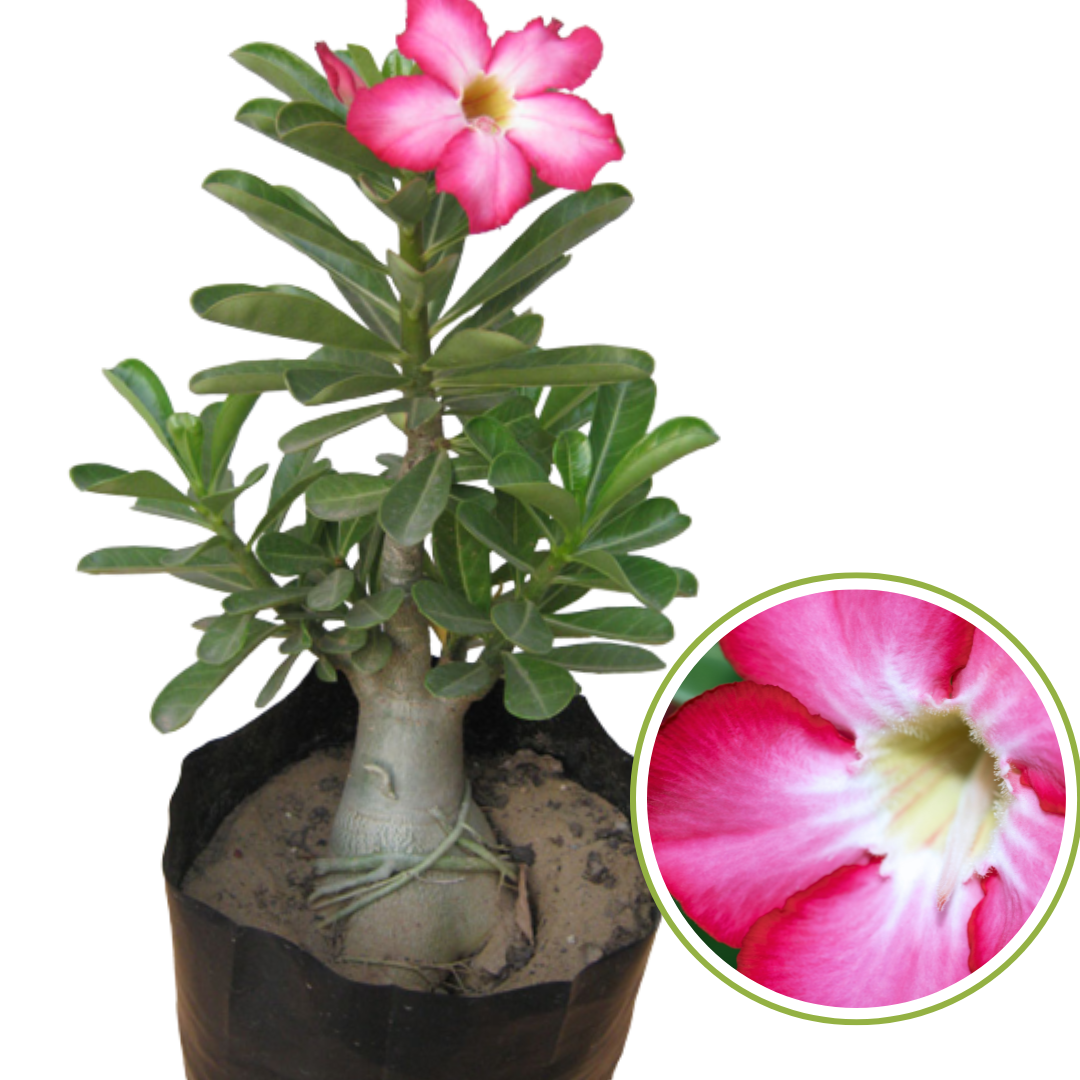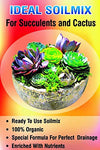



Green Paradise Adenium Plant Pink white Mix Color FLowering With Pot
Rs. 499.00
Guaranteed Safe Checkout
Green Paradise Offers Beautiful Adenium Plant For Bonsai
What is Adenium Plant
The Desert Rose is popular as an ornamental plant but not often seen as a bonsai. It is vigorous and healthy under the right conditions and with proper care. Native to East Africa, the Desert Rose is a small succulent tree that has fresh leaves and develops a bulbous base. It produces large pink and white or red flowers throughout the year when it gets enough sunlight. The Desert Rose adapts easily to growing in a pot, which makes it well suited for bonsai.
Adenium, also known as Desert Rose or Sabi Star, is a succulent plant native to arid regions of Africa and the Arabian Peninsula. It is a popular ornamental plant known for its attractive flowers and unique swollen trunk and branches.
Here are some key features and characteristics of the Adenium plant:
Appearance:
Adeniums have a distinctive caudex, which is a swollen, water-storing base that gives the plant a bonsai-like appearance. The trunk and branches may be thick and gnarled, and the overall growth habit can vary from shrubby to tree-like, depending on the variety. The leaves are thick, leathery, and usually oval or elliptical in shape.
Flowers:
Adeniums produce showy flowers in various colors, including shades of pink, red, white, and purple. The flowers are trumpet-shaped and have five petals that form a star-like pattern, hence the common name "Sabi Star." The flowers typically bloom in clusters at the ends of the branches and have a long blooming period.
Drought tolerance:
Adeniums are succulent plants, meaning they have specialized water-storing tissues that allow them to survive in dry and arid conditions. They are adapted to drought and can withstand extended periods without water. However, they also appreciate periodic watering to support healthy growth and flowering.
Sunlight requirements:
Adeniums thrive in full sunlight and require at least 6 to 8 hours of direct sunlight each day. They can tolerate high temperatures and are well-suited to hot, sunny locations.
Soil and potting:
Adeniums prefer well-draining soil that allows excess water to flow out quickly. A mixture of coarse sand, perlite, and regular potting soil is often recommended. Choose a pot or container with drainage holes to prevent waterlogging, as excessive moisture can lead to root rot.
Watering:
While Adeniums are drought-tolerant, it's important to water them when the soil has dried out completely. Water thoroughly and allow the excess water to drain away. Avoid overwatering, as it can cause root rot. During the dormant period, which is typically in winter, reduce watering frequency.
Pruning and shaping:
Adeniums can be pruned to maintain their desired shape and size. Pruning can help promote branching and encourage more flowers. It is best to prune during the active growing season to minimize stress on the plant.
Propagation:
Adeniums can be propagated through various methods, including seeds, stem cuttings, and grafting. Seeds are the most common method, but they may take a while to germinate. Stem cuttings are a faster way to propagate Adeniums, where a section of the stem is cut and allowed to callus before planting.
Pests and diseases:
Adeniums can be susceptible to pests such as aphids, mealybugs, and spider mites. Regularly inspect the plant for any signs of infestation and take appropriate measures, such as using insecticidal soap or neem oil, to control pests. Overwatering can lead to root rot and fungal diseases, so it's essential to ensure proper drainage.
Adeniums are popular as ornamental plants, particularly in tropical and subtropical regions. They can be grown in containers, making them suitable for balconies, patios, and indoor cultivation in well-lit areas. With proper care and attention, Adeniums can thrive and provide beautiful blooms year after year.
How to Grow Adenium Plant
To grow an Adenium plant (Desert Rose), you can follow these steps:
Planting medium:
Adeniums prefer well-draining soil mixtures. You can create a mixture using equal parts of coarse sand, perlite, and regular potting soil. This combination ensures good drainage while retaining some moisture.
Container selection:
Choose a pot or container with drainage holes to prevent waterlogging. The size of the container should be appropriate for the size of the plant, allowing some room for root growth.
Planting process:
1 . Fill the chosen container with the prepared soil mixture.
2 . Make a small hole in the center of the soil, large enough to accommodate the Adenium's root system.
3 . Gently place the plant in the hole, ensuring that the roots are spread out.
4 . Backfill the hole with soil, gently firming it around the base of the plant.
Sunlight and temperature:
Adeniums thrive in full sunlight. Choose a location where the plant can receive at least 6 to 8 hours of direct sunlight each day. They also prefer warm temperatures between 20 to 30°C (68 to 86°F) during the active growing season.
Watering:
Water the Adenium thoroughly after planting to settle the soil around the roots. Allow the soil to dry out almost completely before watering again. Overwatering can lead to root rot, so it's crucial to let the soil dry between waterings. During the dormant period (usually in winter), reduce watering frequency.
Fertilization:
Adeniums benefit from regular fertilization during the active growing season. Use a balanced, water-soluble fertilizer with an N-P-K ratio of around 10-10-10 or 14-14-14. Follow the instructions on the fertilizer package for the recommended dosage and frequency. Avoid fertilizing during the dormant period.
Pruning:
Pruning can help shape and promote branching in Adenium plants. It is best done during the active growing season. Trim back any leggy or excessively long branches to encourage a more compact and bushy growth habit. Remove any dead or diseased branches as well.
Pests and diseases:
Adeniums can be susceptible to pests such as aphids, mealybugs, and spider mites. Regularly inspect the plant for any signs of infestation, such as visible pests, sticky residue, or distorted growth. Treat infestations promptly with insecticidal soap or neem oil, following the instructions on the product label. Be careful not to overwater, as it can lead to root rot and fungal diseases.
Winter care:
Adeniums are sensitive to cold temperatures and may not tolerate frost. If you live in a region with cold winters, it's advisable to bring your Adenium indoors or protect it from freezing temperatures. Place it in a well-lit location indoors and reduce watering during the dormant period.
Propagation:
Adeniums can be propagated through seeds, stem cuttings, or grafting. Seeds are the most common method, but they require patience as they can take several weeks to germinate. Stem cuttings can be taken from healthy branches and allowed to callus before planting in a well-draining medium.
Remember to monitor your Adenium regularly for signs of growth, pests, or diseases. Adjust your care routine accordingly to ensure your plant remains healthy and thrives in its environment.
𝗥𝗲𝗹𝗮𝘁𝗲𝗱 𝗽𝗿𝗼𝗱𝘂𝗰𝘁𝘀
Flowering Plants
Green Paradise® Pink Lotus Tuber for Pond & Water Gardens – Healthy, Ready to Grow Aquatic Flower Plant Bulb
Green Paradise® Pink Lotus Tuber – Premium Aquatic Flower Plant ✨ Product Description: Bring the beauty of vibrant pink lotus blooms to your water garden or pond with the Green...
Rs. 549.00
Flowering Plants
Rare Heliconia Wagneriana Live Plant Heliconia psittacorum Live Plant
Introducing the Exquisite Heliconia Psittacorum Plant: A Tropical Marvel for Your Home Elevate your indoor and outdoor spaces with the captivating beauty of the Heliconia Psittacorum Plant. Renowned for its...
Rs. 499.00
Flowering Plants
Green Paradise Live-Heliconia Wagneriana Plant with Plastic Pot
Green Paradise Offer Beautiful Heliconia Wagneriana Plant About Heliconia Wagneriana Plant Heliconia wagneriana is a stunning and attractive tropical plant known for its unique and colorful inflorescence. Here's what I can...
Rs. 499.00
Flowering Plants
Heliconia rostrata Live Plant heliconia plant Heliconia psittacorum Live Plant
Introducing the Heliconia psittacorum Plant – Nature's Exotic Masterpiece! About Heliconia Psittacorum Plant: Elevate your garden to new heights with the breathtaking Heliconia psittacorum Plant, a true marvel of nature....
Rs. 499.00
Outdoor Plant
Green Paradise® Water Rose (Pistia) – Live Water Cabbage Aquatic Plant for Ponds, Aquariums & Water Gardens | Natural Oxygenating Floating Plant
Green Paradise® Water Rose (Aquatic Pistia) Plant Welcome to the lush world of Green Paradise® Water Rose (Aquatic Pistia)! Our aquatic plant is more than just a decorative addition to your...
Rs. 399.00
Flowering Plants
Heliconia bird of paradise Live healthy Plant-Green Paradise Live
Green Paradise Offers Beautiful Heliconia Bird Of Paradise Plant About Heliconia Bird Of Paradise Plant It seems like there might be a slight confusion in your question. Heliconia and Bird of...
Rs. 349.00
Seeds
Heliconia Golden Torch plant bulbs positive energy and beautiful flowers giving Plant species. (pack of 3)
Green Paradise offers Heliconia Golden Torch Plant About Heliconia Golden Torch Plant Heliconia Golden Torch is a beautiful and striking tropical plant known for its bright and vibrant inflorescence....
Rs. 399.00
Seeds
Heliconia Plant Bulbs Heliconia bihai x marginata 'Rauliniana' 5 Bulbs-Green Paradise Live
Green Paradise Offers Heliconia bihai x Marginata Rhizomes (Pack of 5 Bulbs) About Heliconia Marginata Heliconia marginata, also known as the Red Bassy or Lobster Claw, is a stunning tropical plant...
Rs. 749.00






